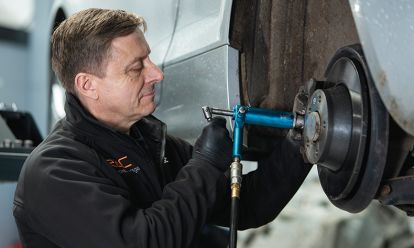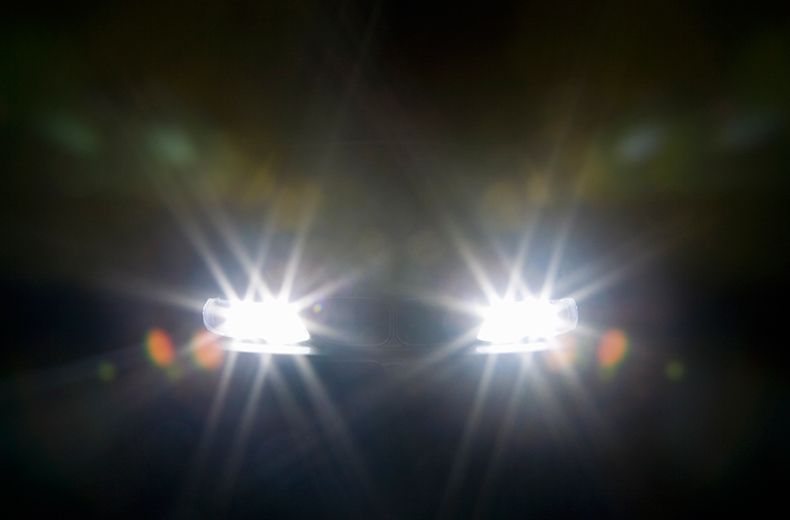The problem of glare from headlights appears to be getting worse with 63% of drivers who get dazzled saying it’s happening more often than a year or two ago, with one-in-four (23%) claiming they’re now dazzled a lot more regularly. And, of all of those who believe headlights are too bright, a huge 64% think they risk causing other drivers to have collisions while two-in-three (67%) say they can’t tell if the headlights of oncoming cars are dipped or on full beam.
Contrary to what might be expected, it’s younger rather than older drivers who are more likely to complain about the apparent brightness of headlights and the effect this has on their driving. Three-in-10 (30%) of those aged 17-34 think most are too bright, compared to just 19% of those aged 65 and over. Meanwhile, of those younger drivers who believe some, if not most, car headlights they see are too bright, 70% think the accident risk is increased – while for drivers aged 65-plus the proportion is 62%.
The brightness of some car headlights even appears to be putting motorists off driving at night. Sixteen per cent of those who complain about the intensity of headlights say they avoid driving at night altogether, with women (22%) and those aged 65 and over (25%) much more likely to say they deliberately don’t drive after dark than men (9%).
The RAC’s research also asked dazzled drivers to estimate how long it typically takes for them to be able to see clearly again. While most (65%) said it took between one and five seconds, one-in-10 (12%) said it took upwards of six seconds. Being unable to see for one second while driving at 60mph means a driver would travel around 13 metres (more than six car lengths), but being blinded for six seconds would see them covering an enormous 160 metres (the equivalent of 40 car lengths), which suggests headlight glare could be compromising safety on the roads.2
While it’s clear that a lot of drivers appear to be suffering from the problems caused by headlight dazzle, many are uncertain as to the causes. For instance, 23% blamed the LED headlights fitted to an increasing number of modern vehicles, and an almost identical proportion (22%) weren’t sure if any particular sort of headlight was to blame, while the remaining third (34%) can’t distinguish between the different types of bulb anyway. However, nearly one-in-five (17%) said they felt the problems are caused by the angle of oncoming vehicles’ beams.
If your vehicle's lights don't seem to be up to the right standard for UK roads, you will need to fix or restore them.
The RAC’s research suggests that the increasing prevalence of vehicles that sit higher on the road, specifically SUVs, might also be exacerbating the problem for those in conventional cars that sit much lower, like hatchbacks, saloons and estates. Six-in-10 drivers (61%) of lower vehicles who said they suffered from glare blamed the headlights on taller vehicles, yet just 28% of drivers of taller vehicles blamed others in similar vehicles.
Motorists’ complaints about the impact some headlights are having on their driving isn’t new, with the RAC first raising the topic in 2018. At the time, the RAC highlighted that the regulations that govern vehicle lighting, including headlights, are decided on at an international (United Nations) level, with input from UK Government. Nearly four years on, drivers remain overwhelmingly supportive of the matter being looked into with 82% saying they’d like something done to help reduce headlight glare.

Complete peace of mind for less
• Cheaper than AA Price Promise or your money back^
• We get to most breakdowns in 60 mins or less
• Our patrols fix 4/5 breakdowns on the spot

RAC spokesperson Rod Dennis said: “It’s clear that the problem of drivers being dazzled by the headlights of others isn’t going away, and in fact our research shows that a large proportion of drivers say they’re getting dazzled more regularly now than a year or two ago. What’s more, and perhaps surprisingly, it’s younger drivers who are more likely to complain about glare which suggests the matter has little – if anything – to do with an individual’s eyesight.
“There are a number of factors that contribute to whether a headlight dazzles another driver or not, the most important being the angle of the headlights as you look at them. If they’re not angled properly – or the driver in the oncoming car has forgotten to dip their headlights – there’s every chance you’re going to get blinded. Modern LED headlight technology may also have a part to play as the human eye reacts to the so-called ‘blue light’ from LEDs differently to the ‘yellow light’ of conventional halogen headlights.
“This presents a real irony: the brighter and better your vehicle’s headlights are, the clearer your night-time view of the road ahead is, often it seems at the expense of anyone coming towards you. The full intensity of your headlights – especially if they’re not angled down correctly – can cause oncoming drivers to momentarily glance away from the road or even be blinded for a few seconds. In short, being dazzled isn’t just about discomfort, it also represents a significant road safety risk.
“But while the apparent dazzling effect caused by headlights is a complicated one, it’s blindingly obvious just how many drivers want the issue looked into by the Government with a view to improving things for the future. Despite the RAC first having flagged drivers’ concerns several years ago, we’re not aware anything at all has happened – which will no doubt be extremely disappointing to many drivers.”
Official government data shows that since 2013, there has been an average of 293 accidents a year where dazzling headlights were a contributory factor. Of these, six were fatal accidents. The actual number may be higher given an investigation may not be able to determine whether or not a collision was directly or indirectly caused by the glare from another vehicle’s headlights.
- Car lights and headlights: what they are and when to use them
- Driving in the dark - tips on how to stay safe
- Daytime running lights: everything you need to know
What can I do if I find I get dazzled?
- Speak to your optician. Eight per cent of respondents to the RAC survey said they’d talked to their optician about glare. For those who wear glasses, a special coating can be added that can go cut down on glare. Around fifth (22%) of drivers said they wear such glasses now.
- Make sure you adjust your rear-view mirror. While some cars have self-dimming rear-view mirrors or tinted rear windows, most require you to manually adjust the mirror in the dark. Doing so can cut down on glare, and it’s something most drivers who get dazzled (57%) said they do at night.
- Think about glare when you change your car. While you’re perhaps more likely to want to get a car with modern headlight technology, if you want to cut down on the dazzling effect of cars behind you then look for one with a self-dimming rear-view mirror and even darkened glass (sometimes called ‘sunset glass’) when you change your car. Both can be effective at reducing the bright light that reaches you.
Am I actually causing other drivers to be dazzled?
It can be extremely difficult to know whether you’re causing discomfort to other drivers from your car’s headlights, and the only way you might know is if you see them flashing at you. But if you suspect a problem with yours, you won’t be alone – around one-in-five drivers (18%) said they’d thought their headlights might be dazzling others.
Check your car’s manual to find out how to adjust the angle of your headlights, depending on the load you are carrying. Even just having all the passenger seats occupied may mean you need to manually adjust the beam, and there’s likely to be a switch close to the dashboard. If you don’t, you could be causing other people problems.
If you think there is a problem with your headlights, contact a reliable approved garage or main dealer as soon as you can. Whatever you do, don’t be one of the 8% of drivers who say they try to physically adjust the headlight bulbs themselves. Figures from the Driving and Vehicle Standards Agency (DVSA) in 2018 showed that of the 26.5m MOT tests completed that year for Class 4 vehicles (which includes cars) over three years of age, 6% failed as result of headlamp aim problems. Two years earlier, in 2016, the DVSA also stated that ‘headlamp aim consistently tops the MOT compliance survey as one of the most likely items to be assessed incorrectly by testers.3
Are you unsure about the current state of the lights on your vehicle? Read our guide on how to check your lights and bulbs, or take your car to a garage for a service.
RAC Breakdown Cover gives drivers complete peace of mind out on the road.
Book a car service today
It’s easy to book a service online at one of our local approved garages. Find a trusted local garage with the RAC stamp of approval.















